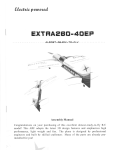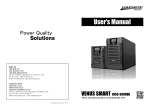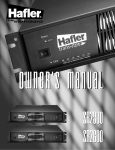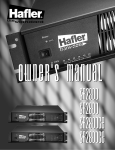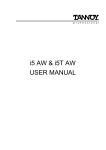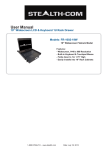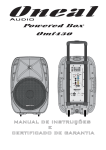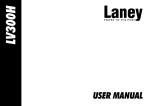Download Hafler MAQ-104 User's Manual
Transcript
OWNER’S MANUAL OWNER’S MANUAL MAQ-104 CAR AUDIO OCTAVE EQUALIZER A Division of Rockford Corporation 613 South Rockford Drive Tempe, AZ 85281 602-967-3565 INDEX . . . . . . . . . . . . . . . . . . . . . . . . . . . . Page 1 Introduction Features . . . . . . . . . . . . . . . . . . . . . . . . . . . . . . Page 1 Nomenclature . . . . . . . . . . . . . . . . . . . . . . . . . . ..Page 2 . . . . . . . . . . . . . . . . . . . . . . . . . . . . . .Page 3 Installation Equalization . . . . . . . . . . . . . . . . . . . . . . . . . . . ..Page 5 Applications . . . . . . . . . . . . . . . . . . . . . . . . . . . . .Page 8 Possible Equalization Curves. . . . . . . . . . . . . . . . . . . .Page 9-10 Specifications . . . . . . . . . . . . . . . . . . . . . . . . . . ..Page 11 Possible System Configurations. . . . . . . . . . . . . . . . . . .Page 12-17 Warranty . . . . . . . . . . . . . . . . . . . . . . . . . . . . . .Page 18 INTRODUCTION Congratulations on your selection of the Hafler MAC-104 Octave Equalizer. You have acquired a product that will greatly enhance the performance of your auto sound system. Because of the sophistication of this advanced electronic device, we recommend that you thoroughly understand the contents of this manual before operation and installation FEATURES Full 4 channel operation maintains ability to fade. > Single chassis provides straight forward installation 10 Bands per channel for optimal adjustment. > + 12dB of boost and cut per band. > Each channels flat position is located by a center click in each potentiometer. Defeat switching front and rear. > Perfect for trouble shooting. > Aid in vehicle curve adjustment > Can be used for 2 channel dual curve installation (See Figure 6) Multi-Mode operation. > 4 channel 4 way > 2 channel 2 way > 2 channel dual curve Programmable remote turn-on delay circuitry. > Switch selectable delay times from .5 to 4 seconds > Remote in from source unit is delayed and then passed on to the amplifiers. > Provides a delay period for the stabilization of all electronics prior to amplification. > Eliminates turn on/off thump. Gold plated RCA Connectors 1 Hinged top provides easy access to crossover modules. > Detailed owner’s manual located conveniently inside hinged top. > Cosmetically "clean” look enhances any installation. > Mounting holes concealed internally. Output sensitivity adjustment. > Insures compatibility with any radio or head piece. > Independent adjustment per channel. NOMENCLATURE Refer to figure 1 for the location of the inputs, outputs, potentiometers, and various switches used in the configuration of the MAQ-104. Front/Rear defeat switch: These two switches will either make the MAQ-104 circuitry active or bypass it completely. See Figure 1 for active/defeat positions. Delay switch: These dip switches remote turn-on delay period. are used to program the Frequency band boost and cut: Each adjustment potentiometers on the MAQ-104 will allow you to boost by turning any potentiometer clockwise, and cut by turning counter clockwise. WARNINGS To prevent possible system damage, please follow the guidelines below. > Never connect or disconnect any component of the sound system while power is applied to the system. > Prolonged exposure to high sound pressure levels can cause hearing impairment - please use common sense when listening to your auto sound system. 2 INSTALLATION The MAQ-104 is a precision piece of electronic equipment and with proper installation will provide years of trouble-free operation. The following steps will help to reduce the amount of time and effort required to install the MAQ-104 > Consult a professional installer if necessary > Mount the unit securely in a clean, dry location using the four internal mounting holes. The four mounting holes are located adjacent to the circuit board > Make sure the installation does not interfere with the normal operation of the vehicle POWER CONNECTOR The four power wires on the MAQ-104 should be connected as follows: Yellow - connect to the + terminal of the battery. Red - Connect to the remote turn-on lead from the source. Black - Connect to the chassis of the vehicle The ground point in the car should be a piece of chassis m e t a l t h a t is welded to the main body of the car. Painted surfaces should be scraped or sanded before the ground lug is bolted down, (Cover the bare metal area with paint or grease to prevent rust.) Blue - Connect to the remote turn-on leads of the amps FUSES The battery wire (yellow) is fused on the circuit board with an AGC 1 amp fast blow fuse. The remote out wire (blue) is also fused on the circuit board with an AGC 1/2 amp fast blow fuse. In order to assure continued protection, replace only with the proper fuse values. See Figure 1 for proper fuse locations. PROGRAMMABLE TURN-ON DELAY The MAC-1 04 has the capability to delay the remote turn-on voltage to the amplifiers by a period of up to 4 seconds. This delay period is necessary in order to allow the signal 3 processing circuitry prior to the MAQ-104 sufficient time to stabilize before power is applied to the amplifiers. This results in minimum turn-on/turn-off thump. . To program the turn-on delay period, set the relay dip switches as shown below: TIME 1 2 0.5 1.0 2.0 4.0 ON ON OFF OFF ON OFF ON OFF FRONT/REAR DEFEAT SWITCHES The switches in figure 1 are shown in the active position (in the up position with the power connector on your upper left.) By pushing the toggle down this defeats each respective front and rear channel. FREQUENCY BAND BOOST AND CUT On the MAQ-104 there are 10 bands of center frequency boost and cut. By selecting a frequency noted on the PC board you can boost or cut any band. Boost is accomplished by tuning the potentiometer clockwise. Cut is done in reverse fashion counter clockwise. The flat position is noted by a center detent on each potentiometer INPUT LEVEL SENSITIVITY The MAQ-104 is designed to be used at pre-amp and radio output levels only (500 to 750 mVRMS). Higher input levels to the MAQ-104 may overload the circuitry and must be attenuated. OUTPUT SENSITIVlTY ADJUSTMENT There are four output gain adjustment potentiometers on the MAQ-104. The output levels must be set in such a way as to not overdrive the amplifiers. A proper adjustment can be achieved by adjusting both the source unit and MAQ-104 output levels. If you find that your 4 over driving the amplifiers turn down the output levels of the source and then fine adjust the MAQ-104. EQUALIZATION Response problems created by the audio environment (the car’s acoustics) usually can be corrected with a good quality equalizer that has flexible and precise adjustment. The MAQ-104 provides this flexibility and precision. Response problems created by poor system design must be corrected at the amp and speaker level. EQUALIZING WITH A REAL TIME ANALYZER For best resolution, a 30-band (1/3-Octave) Real-time Analyzer (RTA) or a swept spectrum analyzer with 1/3-Octave resolution should be used. A lo-band, 1-Octave resolution RTA will give decent results, but is harder to use. Either RTA method will require a pink noise generator. STEP BY STEP 1) Extend MAQ-104 input/output cables and B + , turn-on and ground to a convenient location outside the vehicle. (A kit is available from your Hafler dealer.) 2) Test the system to ensure proper function - “zero” all pots and check level by switching the defeat switch quickly. 3) Position microphone and stand in car seat, head height, ear level (preferably inside ear) with microphone facing forward. Microphone placement will have a significant effect on frequency response, and moving the microphone around in the driver’s area will give a good idea of overall response. 4) Calibrate RTA. 5) Input pink noise to MAQ-104 on channel corresponding with microphone placement. Set volume level to 90-100 dB. 5 BE CAREFUL! PINK NOISE CAN HURT SPEAKERS AT EXCESSIVE VOLUME. MAKE SURE VOLUME ON PINK NOISE GENERATOR IS DOWN BEFORE TURNING ON. 6) Observe output response 7) Turn off pink noise and re-input source. Listen to system with a piece of music you are familiar with. (NACA disc) Does system sound like it looks? If not, reposition microphone until system response looks like it sounds. Major system problems, for instance large response “holes” or “peaks”, should be solved by correcting speaker or system problems. Trying to equalize out large response errors (over 6 dB) will result in overdriven amplifiers and speakers, and should not be attempted 8) Once microphone placement has been verified, reconnect pink noise. 9) Begin to equalize by first adjusting the frequency positions that need to be effected. Since adjacent bands interact with each other, you will need to go back and forth between frequencies to get the best balance 10) Periodically verify curve by listening to your reference music. Equalize one channel at a time. Compare your “EQ’d” curve with the original response by switching defeat switch If it isn’t getting better, return to zero and start again. 11) Once one channel is correctly adjusted, the other channel will come easy. Move the microphone to the opposite side, change the pink noise channel, and equalize for the same response. 12) Make any fine tuning adjustments while listening to both channels simultaneously. 13) Reinstall MAQ-104 functioning. into car. Listen to verify proper SOME SUGGESTIONS: >It is best to equalize one channel at a time. Trying to set all four channels at once confuses which channel is producing the results. > If you can identify a response problem by ear, move the microphone to a point that reveals the problem Mike placement can have a very large effect on 6 response, and some microphone positions will obscure problems instead of showing them. > The audible effect of response problems is a product of both the magnitude of the error and its width. A 9-dB “hole” one/third octave wide is less audible than a 2-dB “dip” two octaves wide. Try for an average response equally above and below the desired response over each octave span. > The human ear averages the overall sound-field response by complex physiological and psychological processing. A single microphone only hears at one point, which must be selected to represent as closely as possible the overall sound field. Since tonal perception is most influenced by the nearest source, we usually equalized each side separately. The mike is set up at the driver’s listening location, facing forward, and the left channel is equalized Then the mike is set up at the passenger’s location and the right channel is set up to match the left. This procedure usually gives good results EQUALIZATION GOALS The primary goal of the MAQ-104 is to produce a smooth response approaching a desired curve, eliminating or reducing peaks and valleys in our system response A system can be equalized for a flat response but in most cases this is a dry and flat response. The best equalization is the one that fits your style of music For example: a curve with the bass boosted would be more realistic to a Rock and Roll type of person, where a partial boost in this section would be more natural to Symphonic Music Figures 2-5 show some typical “good-sounding” system response curves. Curve “2” is a good general-purpose goal. Curve “4” with increased bass will give more impact on Rock-and-Roll, while “3” would sound more natural for Symphonic Music. Curve ”5" illustrates reduced roll-off rate in the mids and highs. These curves are only examples, and the best curve is the one that suits your listening style APPLICATIONS 4 CHANNEL OPERATION 4 Channel operation is accomplished by using all 4 inputs and outputs. Figures 2-3 show typical hook up examples. 2 CHANNEL OPERATION 2 channel operation of the MAC-104 uses only 2 of the 4 inputs. Figures 4-5 show some typical examples. 2 CHANNEL X 2 OPERATION (DUAL CURVE) This is accomplished by feeding the source outputs into both inputs of the MAQ-104. Next tie both the MAQ-104 outputs together. The dual curve option is then produced by making either the front channels active and the rear channels active. The reverse is also possible. See Figure 6 for hook up example. This type of option is well suited for convertible cars that have their hoods up or down. For those people that share a car but have different listening styles, this dual option is also nice. NOTE 1: This option is only two channel operation. NOTE 2: By having both front and rear active at one time you will have little or no output. 8 SPECIFICATIONS The MAQ-104 is deliberatdy restricted to 12 dB of boost or cut per band. This is meant to discourage attempts to correct large system response problemswith the equalizer. System response errors greater than about 6 dB over a span of an octave or more should be corrected elsewhere in the system, by correcting speaker or amplifier problems. Excessive use of equalization is likely to overdrive amplifiers, speakers, or other components. INPUTS Input Level = 750mV RMS Input Impedance = 20K Ohms OUTPUTS Output Level = 750 mV RMS ELECTRICAL Output Impedance =500 Ohms Distortion = Less than .01% THD + N Signal to noise ratio = over 90 dB (A-weighted) Filter Q = 2 typical Power Required = less than 1 amp at 12 volts typical. PHYSICAL Dimensions = 8.000H x 10.125W x 1.75D. Weight = 3 Ibs. 11 WARRANTY From 1 year from the date of purchase (The Warranty Period), Hafler warrants that any unit which fails to function properly under normal use due to a MANUFACTURING DEFECT, when installed and operated according to the Owner’s Instruction Manual enclosed with this unit, will be repaired or replaced, at Hafler’s option, without charge to you for parts or labor for the actual repair work. Proof of purchase must be provided with the returned unit to insure full benefit of the warranty period, for if not, Hafler will be unable to honor the warranty, labor and pans will be charged to you. The product must be delivered within the warranty period, transportation prepaid, to the Hafler Factory, or an authorized Hafler warranty service station together with evidence of date and place of original retail purchase This warranty does not cover damage due to unauthorized repair, nor does it cover damage due to improper shipping by customer. Hafler will pay for the cost of returning the repaired or replacement product to you within the United States This warranty does not cover any appearance item, any accessories used in conjunction with the product, or any damage to the product resulting from the alterations, accident, misuse or abuse. This warranty does not apply if the parts or labor, which would be otherwise provided without charge under this warranty, are obtained from any source other than Hafler or an authorized service center. Hafler limits its obligation under any implied warranties under state laws to a period not to exceed the warranty period. All product returned under warranty must be accompanied by a return authorization number. RA numbers may be obtained by phone at 602-967-3565. Defective product must then be sent prepaid to: HAFLER 613 South Rockford Drive Tempe, AZ 65261 18 Dear Hafler Owner, The gloss black insert on the face-plate of your new Hafler equipment has been packaged with a removable protective coating. Please peel off this protective coating following installation. When cleaning the face plate, we advise a soft cotton cloth with a non-abrasive cleaner that is safe for Lexan and painted surfaces. DO NOT use paper towels or any coarse material to clean the face-plate as these materials may scratch the insert. We are sure you will enjoy your new Hafler product both sonically and cosmetically for years to come. The Hafler Team! 19






















